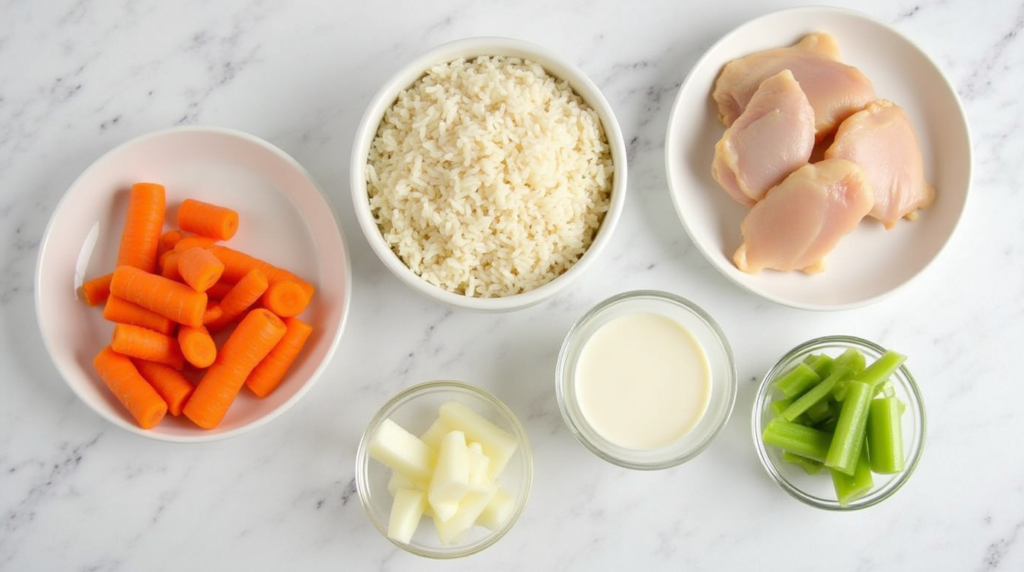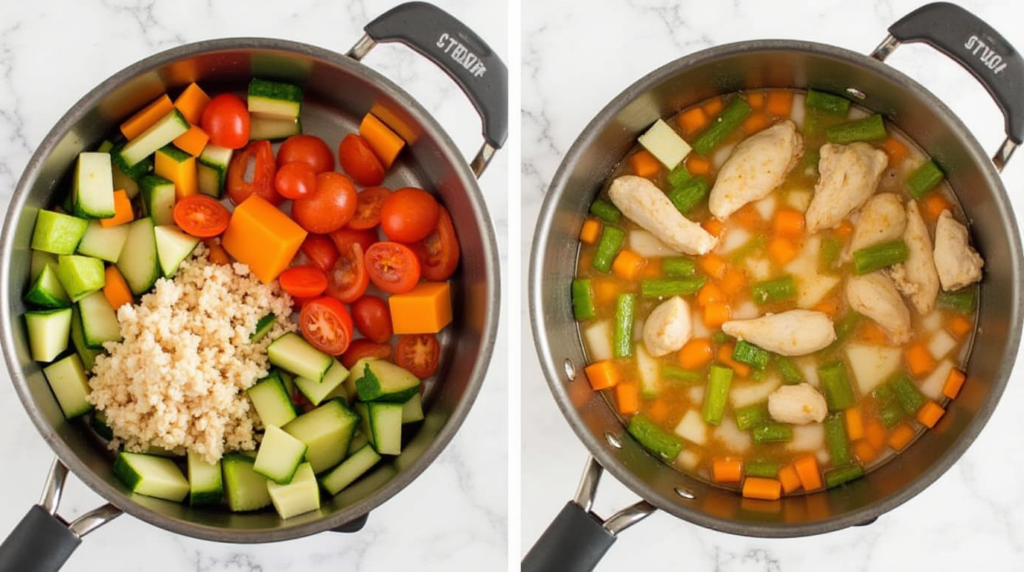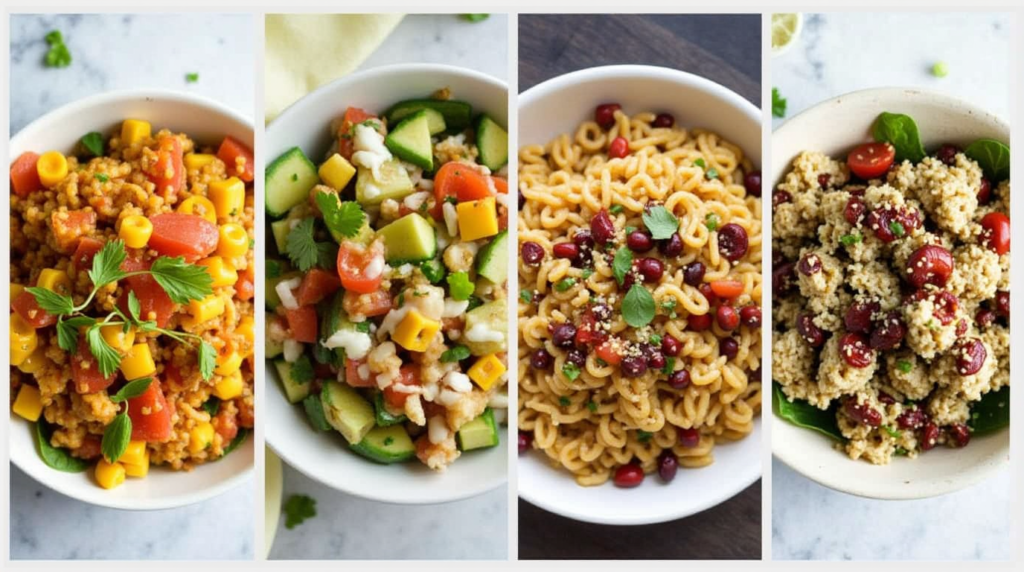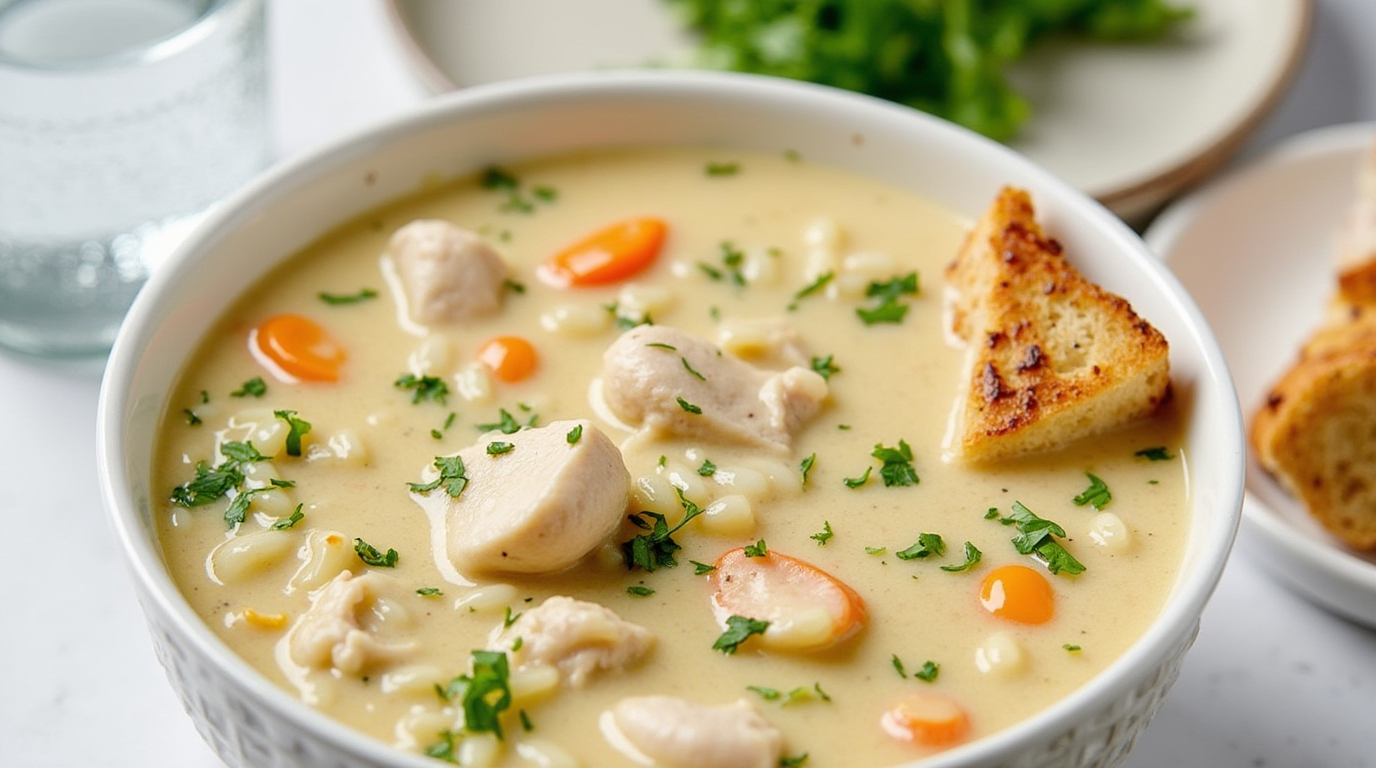Creamy Chicken and Rice Soup Recipe: Cozy One-Pot Comfort
As the weather cools down, there’s nothing like a warm, comforting bowl of comfort food to soothe the soul. For me, a cozy one-pot meal like creamy chicken and rice soup is the perfect remedy for a chilly day or when I’m feeling under the weather.
This recipe is more than just a meal; it’s a hug in a bowl. It’s a simple, satisfying dish that combines tender chicken, flavorful rice, and a rich, creamy texture that’s sure to become a family favorite.
In this article, I’ll share my easy-to-follow recipe for this beloved comfort food, along with some tips to make it your own.
Key Takeaways
- Easy one-pot recipe for a comforting meal
- Perfect for chilly days or when feeling unwell
- Customizable to suit your taste preferences
- Simple ingredients and straightforward instructions
- Nourishing and satisfying meal for the whole family
The Comfort of Homemade Creamy Chicken and Rice Soup
Homemade creamy chicken and rice soup has a way of soothing the soul like few other dishes can. For me, it’s more than just a meal; it’s a source of comfort that never fails to lift my spirits.
Why This Soup Is My Go-To Comfort Food
This soup is my go-to comfort food for several reasons. Firstly, the combination of tender chicken, creamy texture, and flavorful rice is incredibly satisfying. It’s also a dish that reminds me of home and family gatherings, evoking a sense of warmth and nostalgia. The simplicity of its ingredients belies the depth of flavor it offers, making it a staple in my kitchen during the colder months.
The History Behind Chicken and Rice Soup
Chicken and rice soup has a rich history that spans across various cultures. It’s a dish that has been adapted and modified over time, reflecting local tastes and ingredients. The basic concept of cooking chicken with rice and vegetables is universal, yet the specific preparation methods and additional ingredients can vary significantly. This versatility is part of what makes chicken and rice soup such a beloved comfort food around the world.
What Makes This Creamy Chicken and Rice Soup Special
What sets this creamy chicken and rice soup apart is its perfect balance of creaminess and flavor. This soup is more than just a comforting meal; it’s a culinary experience that combines simplicity with rich, satisfying flavors.
The Perfect Balance of Creaminess and Flavor
The creamy texture of this soup is achieved without overpowering the other ingredients, creating a harmonious balance of flavors. The creamy soup recipe incorporates a blend of sautéed vegetables, tender chicken, and perfectly cooked rice, all wrapped in a rich and creamy sauce.
This balance is crucial, as it ensures that the soup is neither too bland nor too overwhelming. The key is in the preparation, where each component is carefully cooked to enhance the overall flavor profile.
One-Pot Convenience for Busy Days
One of the standout features of this one-pot meal is its convenience. In today’s fast-paced world, preparing a delicious and nutritious meal can be challenging, especially on busy days. This soup offers a solution, as it can be cooked entirely in one pot, minimizing cleanup and reducing cooking time.
The simplicity of this recipe makes it an ideal choice for weeknight dinners or whenever a comforting meal is needed quickly. By utilizing a single pot, you can have a wholesome meal ready in under an hour, making it a practical choice for anyone looking for a quick yet satisfying meal.
Essential Equipment for Making Chicken and Rice Soup
When it comes to making a hearty soup, having the right equipment is just as important as the ingredients. The right tools can make the cooking process smoother and more enjoyable, ultimately leading to a more satisfying result.
The Ideal Pot for Soup Making
A large, heavy-bottomed pot is ideal for making easy chicken soup. I prefer a Dutch oven or a similar pot with a thick bottom that distributes heat evenly, reducing the risk of scorching. A pot with a capacity of at least 3 quarts is recommended to accommodate all the ingredients comfortably.
| Pot Type | Capacity | Benefits |
|---|---|---|
| Dutch Oven | 3-4 quarts | Even heat distribution, versatile |
| Heavy-Bottomed Pot | 3-4 quarts | Prevents scorching, durable |
Other Helpful Kitchen Tools
In addition to the ideal pot, other tools can enhance your soup-making experience. A wooden spoon is great for stirring, while a ladle makes serving easy. Having a cutting board and a sharp knife on hand is also essential for preparing ingredients efficiently.
“The right tools make cooking a joy, not a chore.”
Anonymous
Ingredients for the Perfect Creamy Chicken and Rice Soup
Crafting the perfect creamy chicken and rice soup starts with understanding its core ingredients. The quality and combination of these ingredients not only affect the flavor but also the texture and overall comfort of the soup.

Chicken Options and Preparation
The type of chicken used can significantly impact the flavor and texture of the soup. I prefer using boneless, skinless chicken thighs for their tenderness and rich flavor, though breast meat can be used for a leaner option. It’s essential to cut the chicken into bite-sized pieces to ensure it cooks evenly.
Rice Varieties and Their Effects on the Soup
The choice of rice can alter the character of the soup. White rice is traditional and cooks quickly, while brown rice adds a nuttier flavor and more fiber but requires longer cooking times. I often use white rice for a creamy texture, but feel free to experiment with different varieties.
Vegetables and Aromatics
Vegetables and aromatics add depth and complexity to the soup. Onions, carrots, and celery are classic aromatics that form a flavorful base. You can also add other vegetables like peas or diced bell peppers to enhance the flavor and nutritional value.
Creating the Creamy Base
The creamy base is what gives the soup its comforting richness. I achieve this by using a combination of heavy cream and chicken broth. For a lighter version, you can substitute some of the cream with milk or use less cream overall. The key is to balance the creaminess with the other flavors.
| Ingredient | Role in the Soup | Variations |
|---|---|---|
| Chicken | Protein and flavor | Thighs, breast, or a combination |
| Rice | Texture and carbohydrate source | White, brown, jasmine, or basmati |
| Vegetables and Aromatics | Flavor and nutrients | Onions, carrots, celery, peas, bell peppers |
| Cream | Creaminess and richness | Heavy cream, milk, or dairy-free alternatives |
By understanding and selecting the right ingredients, you can create a creamy chicken and rice soup that is both comforting and delicious.
Ingredient Substitutions and Alternatives
The beauty of a creamy soup recipe lies in its flexibility, allowing for various ingredient substitutions. Whether you’re catering to dietary restrictions or simply looking to mix things up, understanding your options can be incredibly helpful when making a homemade chicken soup.
Dairy-Free Options for Creaminess
For those who are lactose intolerant or prefer a dairy-free diet, there are several alternatives to achieve the creamy texture in your soup. You can use coconut milk or coconut cream as a substitute for heavy cream or whole milk. Another option is to use a non-dairy yogurt or cashew cream, which can add a rich and creamy element to your creamy soup recipe.
Gluten-Free Modifications
If you’re cooking for someone with gluten intolerance or sensitivity, it’s essential to choose the right type of rice or modify the recipe accordingly. Opt for gluten-free rice varieties or consider using gluten-free all-purpose flour as a thickening agent if needed. Always check the labels of your ingredients to ensure they are processed in a gluten-free environment.
Vegetable Substitutions and Additions
The versatility of homemade chicken soup allows you to experiment with various vegetables based on what’s available or your personal preferences. Feel free to substitute carrots with parsnips, or add other vegetables like peas, corn, or diced bell peppers to enhance the flavor and nutritional value of your soup.
Preparation Steps Before Cooking
To ensure a smooth cooking process, it’s crucial to take care of a few preparation steps before you start cooking your easy chicken soup. Proper preparation not only makes the cooking experience more enjoyable but also significantly enhances the final result.
Preparing the Chicken
Start by preparing the chicken. If you’re using boneless, skinless chicken breasts or thighs, rinse them under cold water, pat dry with paper towels, and cut them into bite-sized pieces. For whole chickens or bone-in pieces, you may need to season them and let them sit at room temperature for a few minutes before cooking. Properly preparing the chicken ensures it cooks evenly and absorbs flavors well.
Chopping Vegetables for Optimal Flavor
Chopping vegetables is another critical step. Onions, carrots, celery, and any other vegetables you’re using should be chopped into uniform pieces. This uniformity ensures that they cook at the same rate, providing a balanced flavor throughout the soup. Take your time to chop them finely, as this will also help in releasing their natural flavors during cooking.
Measuring and Organizing Ingredients
Measuring and organizing your ingredients is the final step in preparation. Measure out the rice, spices, and any other ingredients according to your recipe. Organize them in a way that makes them easily accessible as you cook. This step is crucial for a one-pot meal, as it allows you to add ingredients at the right time, ensuring that your easy chicken soup turns out perfectly.
By following these preparation steps, you’ll be well on your way to creating a delicious and satisfying one-pot meal that warms the heart. The effort you put into preparing your ingredients will pay off in the flavor and quality of your easy chicken soup.
Step-by-Step Cooking Instructions
Let’s dive into the step-by-step process of making a creamy chicken and rice soup that’s sure to become a family favorite. This comforting dish is not only delicious but also relatively simple to prepare, making it perfect for a weeknight dinner or a cozy weekend meal.

Building the Flavor Base
The foundation of a great creamy chicken and rice soup lies in its flavor base. To start, sauté chopped onions, carrots, and celery in butter until they’re softened and fragrant. This step is crucial as it releases the natural sweetness in the vegetables, which in turn enhances the overall flavor of the soup. As Julia Child once said, “The only time to eat diet food is while you’re waiting for the steak to cook.” In this case, the sautéed vegetables are the steak, adding depth and richness to our soup.
- Melt 2 tablespoons of butter in a large pot over medium heat.
- Add 1 medium onion, diced, and cook until translucent.
- Add 2 stalks of celery and 2 medium carrots, both diced, and continue to cook until the vegetables are tender.
Adding and Cooking the Chicken
Once the flavor base is ready, it’s time to add the chicken. You can use boneless, skinless chicken breasts or thighs, depending on your preference. Cooking the chicken in the pot allows it to absorb all the flavors from the vegetables and butter.
- Add 1 pound of chicken to the pot and cook until it’s browned on all sides.
- Pour in enough chicken broth to cover the chicken and bring the mixture to a boil.
- Reduce the heat to low and let it simmer until the chicken is cooked through.
Incorporating Rice and Liquid
The next step involves adding rice and more liquid to the pot. The type of rice you use can affect the soup’s consistency, so choose a variety that you’re comfortable with. For a creamy soup, it’s best to use a rice variety that absorbs liquid well.
| Rice Type | Liquid Absorption | Best For |
|---|---|---|
| White Rice | High | Creamy Soups |
| Brown Rice | Medium | Hearty, Nutty Soups |
| Arborio Rice | High | Creamy, Risotto-Style Soups |
Creating the Creamy Finish
The final step is what gives our soup its signature creaminess. You can achieve this by adding heavy cream or a mixture of milk and flour as a thickening agent. Stir well to avoid lumps and let it simmer until the soup has reached your desired consistency.
As you finish your creamy chicken and rice soup, remember that the key to a great comfort food recipe is not just the ingredients, but the love and care you put into making it. This soup is sure to become a staple in your household, providing warmth and comfort on chilly days.
Tips for Achieving the Perfect Soup Consistency
When it comes to creamy chicken and rice soup, getting the consistency right is essential. A soup that’s too thick can feel heavy, while one that’s too thin may lack depth. Achieving the perfect balance is key to enjoying this comforting dish.
Managing Rice Absorption
Rice absorption is a critical factor in the consistency of chicken and rice soup. Rice absorbs liquid as it cooks, and if not managed properly, it can make the soup too thick. To manage rice absorption, you can adjust the amount of liquid in the recipe or cook the rice separately before adding it to the soup.
Here’s a simple guide to adjusting liquid based on rice type:
| Rice Type | Liquid Adjustment |
|---|---|
| White Rice | Reduce liquid by 1/4 cup |
| Brown Rice | Increase liquid by 1/2 cup |
| Basmati Rice | No adjustment needed |
Adjusting Creaminess to Your Preference
The creaminess of the soup is another aspect that can be tailored to your liking. If you prefer a lighter soup, you can reduce the amount of cream or substitute it with a lighter alternative. For a richer soup, you can add more cream or use a mixture of cream and butter.
Tips for adjusting creaminess:
- For a lighter version, use less cream or substitute with milk.
- For a richer version, add more cream or mix with butter.
- Experiment with dairy-free alternatives like coconut cream for a different flavor.
Flavor Enhancers and Seasoning Secrets
Elevating your creamy chicken and rice soup to the next level involves more than just following a recipe; it requires understanding the nuances of flavor enhancers and seasoning secrets. A well-balanced homemade chicken soup can become a family favorite with a few simple tweaks.
Herbs That Complement Chicken and Rice Soup
Herbs play a crucial role in enhancing the flavor of your creamy soup with vegetables. Popular choices include thyme, parsley, and bay leaves, which add depth without overpowering the dish. Fresh or dried herbs can be used, depending on availability and personal preference.
- Thyme adds a slightly earthy tone.
- Parsley contributes a fresh, green flavor.
- Bay leaves provide a mild, savory depth.
Balancing Salt, Acid, and Umami
Achieving a balanced flavor involves adjusting salt, acid, and umami levels. Salt enhances overall flavor, while a splash of lemon juice or vinegar adds a necessary brightness. Umami, found in ingredients like mushrooms or soy sauce, adds richness and depth to your soup.
To balance these elements, taste your soup regularly as you cook, making adjustments as needed. This ensures your creamy chicken and rice soup is both comforting and complex.
Troubleshooting Common Soup Issues
Making an easy chicken soup doesn’t mean you won’t encounter problems along the way. Even with careful preparation, issues can arise that affect the final dish. Here are some common problems and their solutions to help you achieve a perfect creamy chicken and rice soup.
Fixing a Soup That’s Too Thick or Too Thin
If your soup is too thick, you can thin it out with a bit more chicken broth or water. On the other hand, if it’s too thin, you can simmer it for a longer period to reduce the liquid, or add a slurry made from cornstarch and water to thicken it. Adjusting the consistency is key to achieving the perfect creamy soup recipe.
Rescuing Overcooked Rice
Overcooked rice can make your soup unappetizingly mushy. To rescue it, you can try adding some freshly cooked rice to the soup to restore texture. Alternatively, blending a portion of the soup can help break down the rice and create a creamier consistency. It’s all about finding a balance that works for your creamy chicken and rice soup.
Balancing Flavors When Something’s Off
If the flavors in your soup are off, it might be due to an imbalance of salt, acidity, or umami. Taste and adjust by adding more of what it lacks. For instance, a squeeze of fresh lemon juice can brighten up the flavors, while a bit more salt can enhance the overall taste. Balancing flavors is crucial for a delicious easy chicken soup.
Variations on the Classic Creamy Chicken and Rice Soup
The versatility of Creamy Chicken and Rice Soup makes it an ideal canvas for culinary creativity, allowing for a wide range of variations. By incorporating different ingredients and flavors, you can transform this comforting dish into a variety of exciting meals that cater to different tastes and dietary preferences.

Southwestern Twist with Chilies and Corn
To give your Creamy Chicken and Rice Soup a Southwestern twist, consider adding diced chilies and corn. This variation introduces a spicy kick and a burst of sweetness, enhancing the overall flavor profile. You can also incorporate cumin and chili powder to deepen the flavor, making it a hearty soup perfect for cold evenings.
- Add diced green chilies for an extra spicy kick.
- Incorporate frozen corn kernels towards the end of cooking to preserve their sweetness.
- Use pepper jack cheese instead of regular cheddar for an additional layer of spice.
Mediterranean Version with Lemon and Herbs
For a Mediterranean-inspired version, infuse your soup with the brightness of lemon and the freshness of herbs like thyme and oregano. This variation is perfect for those looking for a lighter, yet still comforting, meal. Adding a squeeze of fresh lemon juice and some chopped fresh herbs towards the end of cooking can significantly enhance the flavor.
- Add a squeeze of fresh lemon juice before serving.
- Incorporate chopped fresh herbs like parsley, thyme, or oregano.
- Use chicken broth with a hint of lemon for added depth.
Asian-Inspired with Ginger and Coconut Milk
Transform your Creamy Chicken and Rice Soup into an Asian-inspired dish by incorporating ginger and coconut milk. This version is not only creamy but also rich in flavor, with the ginger adding a warm, spicy undertone. Using coconut milk instead of traditional cream gives the soup a unique twist and makes it a great one-pot meal option.
- Grate fresh ginger and sauté it with the initial vegetables.
- Replace heavy cream with coconut milk for a dairy-free alternative.
- Add a splash of soy sauce or fish sauce for umami flavor.
Hearty Winter Version with Root Vegetables
For a heartier winter version, incorporate root vegetables such as carrots, parsnips, and celery root into your Creamy Chicken and Rice Soup. This variation not only adds natural sweetness but also increases the soup’s nutritional value, making it a perfect comfort food for colder months.
- Dice root vegetables and sauté them with onions and garlic.
- Use a mix of chicken and vegetable broth for added depth.
- Consider adding potatoes for an even heartier soup.
Make-Ahead and Meal Prep Strategies
To save time during the week, consider making components of the creamy chicken and rice soup in advance. This approach not only saves time but also ensures that you have a delicious, homemade meal ready when you need it.
Components You Can Prepare in Advance
Several components of the creamy chicken and rice soup can be prepared ahead of time. You can chop the vegetables, such as onions, carrots, and celery, and store them in airtight containers in the refrigerator for up to a day. Additionally, you can prepare the chicken by seasoning and even browning it a day before. The rice can also be cooked in advance, though it’s best to cook it just before serving to avoid overcooking.
How to Store Prepped Ingredients
Proper storage of prepped ingredients is crucial to maintaining their freshness and safety. Store chopped vegetables in airtight containers or zip-top bags, keeping them refrigerated at a temperature below 40°F (4°C). Cooked chicken should be cooled promptly and refrigerated within two hours of cooking. You can also freeze cooked chicken for longer storage. Use airtight, freezer-safe containers or bags to prevent freezer burn.
| Ingredient | Storage Method | Storage Duration |
|---|---|---|
| Chopped Vegetables | Airtight container in refrigerator | Up to 1 day |
| Cooked Chicken | Airtight container in refrigerator | Up to 3 days |
| Cooked Chicken | Freezer-safe container or bag | Up to 3 months |
Serving Suggestions and Pairings
A bowl of creamy chicken and rice soup is a meal in itself, but the right pairings can make it truly unforgettable. To enhance your dining experience, consider the following accompaniments and beverages that complement this comfort food recipe perfectly.
Bread and Cracker Accompaniments
Bread and crackers can add a delightful crunch to your meal. For a classic combination, try serving your easy chicken soup with crusty bread or a side of oyster crackers. For a twist, consider garlic bread or flavored crackers like rosemary thins.
Side Salads That Complement the Soup
A fresh side salad can provide a refreshing contrast to the richness of the soup. A simple green salad or a more substantial grain salad can work well. Consider a mixed greens salad with a light vinaigrette or a quinoa salad with roasted vegetables for a nutritious and filling meal.
Beverage Pairings for a Complete Meal
The right beverage can elevate your meal. For a comforting match, try pairing your soup with a warm drink like tea or hot chocolate. Alternatively, a glass of chilled white wine or a sparkling water with lemon can cleanse your palate between spoonfuls.
| Beverage | Reason |
|---|---|
| Hot Tea | Complements the warmth and comfort of the soup |
| White Wine | Pairs well with the creamy texture and flavors |
| Sparkling Water with Lemon | Cleanses the palate between spoonfuls |
Storing, Freezing, and Reheating Your Soup
To effectively store and enjoy my creamy chicken and rice soup later, understanding the best practices for refrigeration, freezing, and reheating is essential.
Refrigeration Guidelines
When refrigerating, cool the soup to room temperature within two hours of cooking to prevent bacterial growth. Store it in airtight containers to maintain freshness. The soup typically lasts for 3 to 4 days in the refrigerator.
Freezing Techniques
For longer storage, freezing is a great option. Cool the soup completely before transferring it to freezer-safe containers or freezer bags, leaving some space for expansion. Label the containers with the date and contents. Frozen soup can be stored for up to 3 months. When reheating, thaw overnight in the refrigerator or reheat directly from frozen, adjusting the cooking time as needed.
FAQ
What is the best type of rice to use for creamy chicken and rice soup?
I recommend using a high-quality white or brown rice that’s suitable for soup making. Some popular options include jasmine, basmati, or regular long-grain rice. The key is to choose a rice variety that absorbs flavors well and cooks evenly.
Can I make creamy chicken and rice soup in advance?
Yes, you can prepare certain components of the soup ahead of time. I often chop vegetables, marinate the chicken, and measure out spices in advance to streamline the cooking process. However, I recommend cooking the soup fresh for the best flavor and texture.
How do I achieve the perfect creamy consistency in my chicken and rice soup?
To get the perfect creamy consistency, I suggest using a combination of heavy cream or half-and-half and a roux-based thickener. You can also adjust the amount of liquid and simmer the soup to reduce it to your desired consistency.
Can I make dairy-free or gluten-free versions of creamy chicken and rice soup?
Absolutely! For a dairy-free version, you can substitute heavy cream with a non-dairy alternative like coconut cream or almond milk. For a gluten-free version, be sure to use gluten-free chicken broth and check the ingredients of your rice and spices to ensure they’re gluten-free.
How can I prevent my rice from becoming mushy or overcooked in the soup?
To prevent mushy rice, I recommend cooking the rice until it’s just tender, then adjusting the cooking time based on the soup’s overall cooking time. You can also add the rice towards the end of the cooking time to prevent it from becoming overcooked.
What are some common mistakes to avoid when making creamy chicken and rice soup?
Some common mistakes to avoid include overcooking the rice, not adjusting the seasoning, and not simmering the soup long enough to develop the flavors. By being mindful of these potential pitfalls, you can create a rich and satisfying soup.
Can I freeze creamy chicken and rice soup, and if so, how?
Yes, you can freeze creamy chicken and rice soup. I recommend cooling the soup to room temperature, then transferring it to airtight containers or freezer bags. When you’re ready to reheat, simply thaw the soup overnight in the refrigerator or reheat it gently on the stovetop or in the microwave.
How can I reheat creamy chicken and rice soup without it becoming too thick or separating?
To reheat the soup without it becoming too thick or separating, I suggest reheating it gently over low heat, whisking constantly. You can also add a little extra liquid, such as chicken broth or cream, to thin out the soup to your desired consistency.
Leave a Review & Rate This Recipe!
There are no reviews yet. Be the first one to write one.

